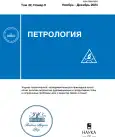Том 32, № 6 (2024)
Статьи
О.А. Богатиков 15.12.1934 – 01.03.2022
 646-646
646-646


Гранитоидные интрузии на краю Курского блока как часть палеопротерозойской кислой крупной изверженной провинции Восточной Сарматии
Аннотация
На восточной окраине архейского Курского блока Сарматии широко проявлен палеопротерозойский диорит-гранодиоритовый магматизм с возрастом 2.04–2.08 млрд лет. Гранитоиды интрузивных массивов являются метаглиноземистыми известково-щелочными породами I-типа, обогащены несовместимыми элементами (LILE и LREE), с отрицательными Ti-, P- и Nb-аномалиями. Они характеризуются широким диапазоном отрицательных значений εNd(T) в породах и εHf(T) в цирконах и глубин зарождения расплавов с гетерогенными архейскими нижнекоровыми базитовыми источниками. Наиболее низкорадиогенные древние коровые источники имеют диориты. Гранодиориты имеют палео- и мезоархейские и более ювенильные неоархейские источники. Причиной интенсивного магматизма с возрастом около 2.06 млрд лет был подъем астеносферной мантии при разрушении пододвинутой океанической плиты в результате пологой субдукции. Ее разрушение и мафический андерплэйтинг привели к внутрикоровому плавлению в верхней плите, состоящей из спаянных в результате предшествовавшей аккреции разновозрастных фрагментов архейской и палеопротерозойской коры. Диорит-гранодиоритовые магмы образовались в разноглубинных очагах плавления в древней архейской коре на окраине Курского блока с вовлечением в источники расплавов фрагментов палеопротерозойской литосферы Восточно-Сарматского орогена.
 647-678
647-678


Петрогенезис гранитоидов крупных салических изверженных провинций (Центральная и Северо-Восточная Азия)
Аннотация
Крупнейшие гранитоидные провинции Центральной и Северо-Восточной Азии (Ангаро-Витимская, Хангайская, Калба-Нарымская, Колымская) подразделяются на ареальный и линейный типы, существенно различающиеся по площади и объему гранитоидов в их составе. Предполагается, что эти различия обусловлены строением и структурой догранитного фундамента и масштабом теплового воздействия на нижние и средние горизонты континентальной коры. Важным фактором формирования гранитоидных провинций является мантийный мафический магматизм, предполагаемые масштабы которого коррелируют с объемно-площадными характеристиками гранитоидных провинций. Роль мафического магматизма заключается в дополнительном привносе тепла, от части флюидов в область плавления коровых протолитов, а также в вещественном вкладе, который реализуется через различные механизмы смешения магм. Наиболее эффективным является смешение на глубинном уровне, в результате которого образуются значительные объемы салических магм повышенной основности. Петрогенетическая роль смешения контрастных магм на мезоабиссальном уровне земной коры, а также в гипабиссальных условиях невелика, однако образующиеся в этом процессе минглинг-дайки используют как ключевой аргумент в обосновании синхронности мафического и гранитоидного магматизма. Гранитоиды салических крупных изверженных провинций (SLIPs) характеризуются гетерогенным изотопным составом, в целом отвечающим параметрам континентальной коры. Крайне высокая гетерогенность пространственно сопряженных гранитоидов обусловлена смешением салических магм, образованных за счет плавления небольшого числа контрастно различающихся по изотопному составу источников, в том числе, посредством смешения с магмами мантийного генезиса. Мафические породы, входящие в состав гранитоидных провинций, соответствуют изотопному составу обогащенной мантии (Ангаро-Витимский батолит) либо указывают на значительный вклад контаминации материалом континентальной коры (Хангайский ареал). Металлогения SLIPs определяется величиной эрозионного среза и типом коровых протолитов, от степени метаморфизма которых в значительной мере зависит исходное флюидосодержание салических магм. Плавление высокометаморфизованных древнекоровых протолитов продуцирует относительно «сухие» салические расплавы, плавление низкометаморфизованных коровых источников приводит к образованию «водных» расплавов, дифференциация которых завершается пегматитообразованием с редкометальной минерализацией. Формирование SLIPs несубдукционного генезиса связано с воздействием мантийных плюмов (в виде синхронного базальтоидного магматизма) на разогретую кору молодых орогенных областей, где тектонические процессы завершились не более первых десятков миллионов лет назад.
 679-709
679-709


Раннемезозойские Петрогенезис гранитоидов Центральной Монголии: к истории формирования Хэнтейского сегмента Монголо-Охотского пояса
Аннотация
В Центральной Монголии широко распространены бимодальные базальт–трахит–щелочно-риолитовые ассоциации с участием щелочных гранитов. Их выходы связаны с небольшими субширотными грабенами, рассредоточенными по южному и западному обрамлению Хэнтейской части Монголо-Охотского пояса. Согласно геохронологическим исследованиям, формирование бимодальных ассоциаций произошло в конце триаса–начале юры (220–195 млн лет). Породы бимодальных ассоциаций обладают повышенной щелочностью и редкометальностью. Их формирование происходило при ведущей роли процессов фракционирования, обеспечивших накопление редких элементов до рудных концентраций в наиболее дифференцированных расплавах. Исходными для пород этих ассоциаций служили базитовые магмы, обогащенные относительно OIB большинством несовместимых элементов. При этом они обладали повышенным содержанием Ва и пониженными Ta и Nb, что указывает на участие в их образовании литосферного компонента. Изотопный состав Nd и Sr в породах отвечает участию в магмообразовании по меньшей мере двух источников, которые в соответствии с геохимическими данными определяются как обогащенная астеносферная мантия и метасоматически измененная литосферная мантия. Бимодальный магматизм проявился в Хэнтейском сегменте Монголо-Охотского пояса спустя ~30 млн лет после завершения коллизионных процессов, зафиксированных временем закрытия Ада-Цагской ветви Монголо-Охотского океана около 250 млн лет. Рифтогенез, контролировавший этот магматизм, протекал по всему обрамлению Хэнтейской части пояса. Он связывается с коллапсом орогена, сопровождавшимся, по-видимому, деламинацией его киля, что обеспечило активное участие астеносферной мантии в позднетриасовом–раннеюрском магматизме региона.
 710-734
710-734


Калиевый щелочной вулканизм вулкана Алаид (Курильские острова): роль субдукционного меланжа в магмогенезисе
Аннотация
Представлены новые данные по содержаниям главных элементов и микроэлементов, Sr-Nd-Pb изотопов в голоценовых высококалиевых основных лавах вулкана Алаид, расположенного на севере Курильской островной дуги в зоне сочленения с Камчатским вулканическим сегментом. По петрохимическим критериям выделяются две группы одновозрастных пород – Ne-нормативные шошониты и высококалиевые субщелочные базальты, близкие между собой по ряду геохимических признаков. Хондрит-нормализованные спектры распределения REE показывают обогащение LREE при плоских спектрах распределения HREE, отсутствие Eu- и Ce-аномалий, а нормализованные к MORB концентрации некогерентных элементов – обогащение LILE и хорошо выраженную негативную Ta-Nb-Ti аномалию, типичную для надсубдукционных вулканитов. Высокие K2O/Rb и Rb/Sr значения свидетельствуют о присутствии в магматическом источнике биотита и амфибола, а низкие величины Sr/Y и плоские спектры распределения средних и тяжелых лантаноидов – об отсутствии граната в реститовом парагенезисе. Существенные вариации содержаний макро- и микрокомпонентов при близкой концентрации MgO свидетельствуют о гетерогенном магматическом источнике, а с учетом линейных трендов смешения на изотопных и дискриминационных диаграммах и экспериментальных данных предполагается вовлечение в магмогенезис не только перидотитовой мантии, но и амфибол-клинопироксенового минерального парагенезиса. Анализ литературных данных показывает, что в «холодных» островных дугах проявления калиевого щелочного магматизма, часто, если не во всех случаях, связано с зонами локального растяжения. Поскольку такие зоны связывают с адиабатическим подъемом горячей и пластичной астеносферы, можно предполагать вовлечение в плавление субдукционного меланжа, образованного вдоль границы слэба и надсубдукционной мантии, состоящего из гидратированных обломков ультрабазитов и метаморфизованной океанической коры, преобразованной в амфиболсодержащие пироксениты. Такой механизм позволяет логично объяснить геохимические и изотопные особенности аномального щелочного магматизма Курильской островной дуги, связь с аномальной тектоникой ее северного сегмента. Полученные результаты могут быть важны при обсуждении генезиса калиевых щелочных магм, проявленных в субдукционных геодинамических обстановках.
 735-751
735-751











